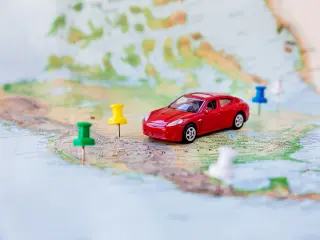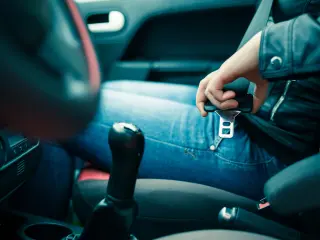How far is it safe to drive in one day?
Knowing how far it is safe to drive in one day can be tricky to get your head around, particularly if you're new to long drives or setting off on your first ever road trip.
Although this may seem like one of those classic 'how long is a piece of string?' questions, there are a handful of things to bear in mind when you're calculating how long you can spend behind the wheel at any one time.
As a general rule, it's safe to drive for no longer than eight hours a day, taking breaks of at least 15 minutes every two hours. This means you can safely drive for around 500 miles, not taking into account external factors such as slowing for tolls, traffic, travelling with children, and tiredness.
We've put together a guide to help you calculate how far you can safely drive in one day, drawing on this general guideline and factoring in circumstances that will affect your own driving experience.
The main thing to remember is that every driver is different, and every car journey has its own hurdles thrown in, so the distance you can safely drive in one day will probably be slightly different depending on your specific situation.
Read on to get clued-up on what could affect your driving experience, and factor in any potential journey-lengtheners to your road trip plan to make sure you drive safely and aren't tempted to cram too many miles into a single day.

How far it's safe to drive if you're travelling alone
If you're considering going solo on your next road trip, then it's very important to think about how many miles you can travel in one day - you've got to be realistic and put your safety first.
In our post on how often you should stop on a road trip, we recommend drivers have a 15-minute rest every two hours to break up the long periods of concentration, allowing them to re-group and feel refreshed for the next leg of the journey.
Considering that drivers shouldn't stay behind the wheel for more than eight hours a day, at least three breaks would be necessary across a full day's drive, meaning the maximum time spent actually driving is around seven hours and 15 minutes.
Let's presume, then, that if a driver is travelling at an average speed of 70 mph on the motorway throughout the day (not factoring in having to slow down for tolls, traffic, or a change of route) - they should be able to cover a maximum of around 507 miles in one day.
Bear this in mind as you're planning your route, choosing hotels and finding places to explore that are at a maximum of 500 miles apart so that the stretches of your journey are safe and manageable.
At the same time, remember - this is just a general calculation on paper that won't necessarily apply to everyone.
The fact that you're driving alone means that your alertness and concentration is all in your own hands - there's no copilot there to help keep you focused.
This means that you might not always feel up to that 500-mile stretch ahead of you, making it safer to reduce the amount of road you cover on some days during your road trip.
On top of this, age, driving experience, road conditions, and your well-being will also affect the distance you'll be able to safely travel in one day, so always stop if you need to, and cut a drive short if you don't feel it's safe to continue.

How far it's safe to drive if you're travelling with two or more drivers
With two or more passengers in the car that can share the driving, you'll be able to make it much further as each person will have time to rest in between stretches.
In theory, with two drivers you should be able to travel 1,000 miles over 16 hours without stopping, seeing as one person can sleep while the other drives.
Unfortunately it's not quite that straightforward, and we'd recommend erring on the side of caution.
Trying to rest while sitting upright in a moving car is no substitute for a good night's sleep in a warm bed, so even after a two-hour snooze in the passenger seat, the second driver is likely to feel just as tired as the first after eight hours on the road.
The moral of the story? Regular breaks are still 100% necessary, even if you're sharing the driving responsibilities with someone else.
Taking all this into consideration, a car with two driving passengers can likely cover around 700 miles safely over a maximum of ten hours, as long as you share driving and take the necessary breaks.
As well as allowing you to travel further, sharing the driving also makes the trip less daunting, means there'll be someone else in the car to keep you focused and entertained, and makes it a whole lot more fun!
How far it's safe to drive if you're travelling with kids or pets
Having young passengers or pets in the car with you can have a massive effect on the distance you can safely drive in one day for a few reasons.
Firstly, let's face it - children and animals are pretty needy, which means they're always after attention and entertainment. This will ultimately mean the driver is more distracted, forced to concentrate even more and as a result, becomes tired more quickly.
The more quickly the driver gets worn out, the fewer miles he or she will be able to safely drive.
Young children and pets will also need more frequent stops than just the regulation two-hour intervals, for toilet breaks, snack top-ups, and time to blow off some steam. These extra stops will inevitably eat into the eight-hour driving window, which means you'll cover less ground.
Remember - young passengers and furry friends can be pretty unpredictable, so don't be surprised if you're unable to drive as far as you expected.
It's almost impossible to predict a specific number of miles you can safely cover when travelling with children and pets, however the most important thing to remember is to stop if you need to, accept inevitable delays, and be flexible with your plans to stay as safe as possible.

How far it's safe to drive also depends on the time of day and how often you're planning on driving
If you're setting off fresh-faced in the early morning after a good night's sleep with eight hours of sunlight stretching before you, you're probably going to be able to safely drive a lot further than if you set off at 4pm after the hangover from the night before has finally worn off.
If you've got a long drive coming up, then plan ahead and be sensible about it - make sure you get an early night, and ideally set off with enough time to reach your destination before it gets dark. That way, you should be able to cover those 500 miles in eight hours with no problem at all.
Your capacity to drive long distances safely will also largely depend on what you're doing in the time surrounding your drive. That's to say, the 500-miles-in-eight-hours estimate presumes that you're doing a one-off drive.
The reality of road trips, however, is that they're often multi-stop, which means you'll be doing long drives for days on end.
By day three or four, you may well start to get tired from all the prolonged periods of concentration and activities at your stop offs, reducing how far you can safely drive.
This, once again, brings us back to one important fact: everyone's different and driving under different circumstances, so listen to your own needs and those of your passengers, and always call it a day if you have any doubt that you can safely continue.










